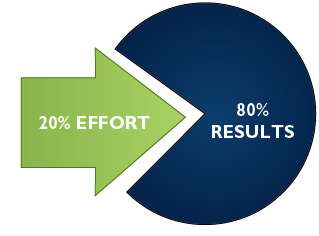“The idea is that in many systems there is inequality between causes and effects. Real-world examples include that 80% of all complaints will come from 20% of customers, and that 80% of sales will be made by 20% of staff. In the martial arts world, the theory is that 20% of all techniques account for 80% of success, therefore 80% of training should be built around those 20% of techniques.”
David explores the challenge of applying the Pareto Principle to training by discussing the difficulty of defining “basic” techniques and by citing the success of high level grapplers that have made complex, advanced techniques (that most grapplers probably would not have been grouped into the 20% of all techniques that are effective). These are issues worth exploring, and Matt from Aesopian.com is leading the debate, but for our purposes, the Pareto Principle provides useful guidance.
To get back into fight shape, I know that I need to refresh my jiu-jitsu through repetition and trigger training. Unfortunately, my time is limited. I cannot possibly drill every technique that I have earned. Instead, I plan to dedicate the majority of my training time to my core game plan, which I have designed (with the help of my instructors and training partners) to repeat a lot of the same movements and tactics in a variety of positions. By creating as much overlap as possible in my game plan, I can cover a lot of ground by training a relatively small batch of techniques. In five years of training, I have been exposed to a lot of technique, but I focus my drilling on the 20% that works for me. This will make recovery a bit easier.
When I work with new students, I try to encourage them to adopt a similar mindset, but it’s difficult to pick the best weapons for you without first broadening your horizons and accumulating a significant collection of attacks. So, with new students, I find myself encouraging them to pick two or three techniques—that connect, preferably—and drilling those techniques after each class and after open mat, an extra 20 repetitions at least. These extra repetitions help to develop their muscle memory and help them to develop their 20% (thank you, David for providing a concept that explains this training practice).
20 repetitions after class may sound insignificant, but it’s part of a 20 Mile March. The concept of the 20 Mile March is something that Jim Collins, a business author, writes about in his book Great by Choice. Collins argues that the most successful businesses (and individuals in general) are the ones that set reasonably challenging goals and stick to them in good times and bad. The unsuccessful companies go hard, clocking 50 miles when times are good, and scale back to 5 or 10 miles when times are bad. In the short run, the 20 Mile Marchers seem to fall behind, but in the long run, their consistency allows them to perform at least 10 times better than their competitors.
I do my best to 20 Mile March, and I encourage you to as well. Set realistic goals that you can keep week to week for years to come. When is a pretty good diet better than the ulta-perfect super strict diet? When you can keep it. When is training three times a week better than training 7 days a week? When you can do it for 10 years. Going hard and going big is admirable, but consistency is key, and that’s been a hard lesson for me to learn. Take your favorite 20% techniques and start drilling a few each month with a schedule that you can keep. It will make a big difference in your game, and it will make returning from an injury a bit easier if you are ever faced with that challenge.


No comments:
Post a Comment